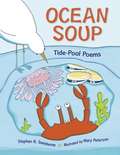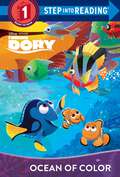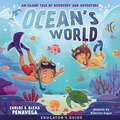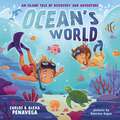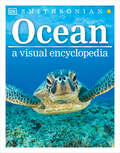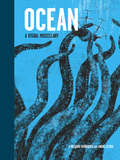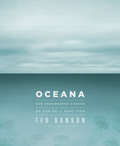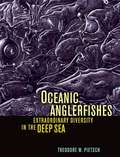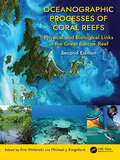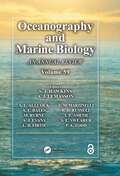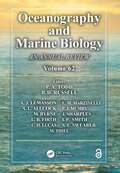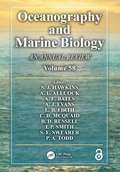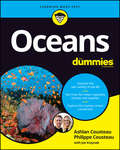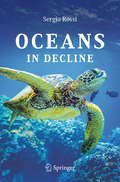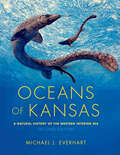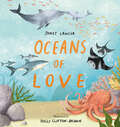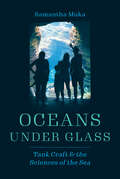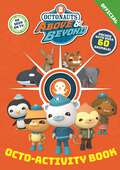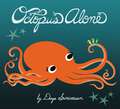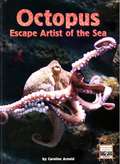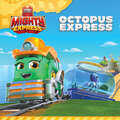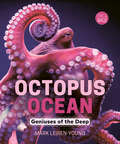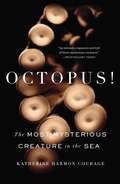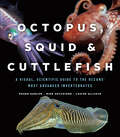- Table View
- List View
Ocean Soup: Tide-Pool Poems
by Stephen R. SwinburneWhen the tide goes out, a briny soup is trapped among the rocks. Playful poems introduce readers to these salty creature--from the self-satisfied anemone that brags about its home to barnacles that perform a rap about their feeding technique.
Ocean of Color (Step into Reading)
by Bill ScollonDisney/Pixar Finding Dory reunites the friendly-but-forgetful blue tang fish with her loved ones, and everyone learns a few things about the true meaning of family along the way. This Step 1 Step into Reading leveled reader based on the film is perfect for boys and girls ages 4 to 6. Step 1 Readers feature big type and easy words. Rhymes and rhythmic text paired with picture clues help children decode the story. For children who know the alphabet and are eager to begin reading.
Ocean's World Educator's Guide: An Island Tale of Discovery and Adventure (Ocean’s World)
by Carlos PenaVega Alexa PenaVegaOcean's World Educator's Guide is a companion to Ocean's World: An Island Tale of Discovery and Adventure by Carlos PenaVega and Alexa PenaVega. This guide can be utilized in the classroom, in a home school setting, or by parents seeking additional resources. Ideal for ages 4-8.
Ocean's World: An Island Tale of Discovery and Adventure (Ocean’s World)
by Carlos PenaVega Alexa PenaVegaJoin Ocean and Kingston as they explore the ocean, discover wildlife, and learn fascinating marine facts in Ocean's World, an action and adventure story for kids!Ocean and his little brother, Kingston, explore the beautiful island of Maui in search of a sunrise shell for their mom&’s birthday gift. But with a rumbling volcano and so much to unearth, will the boys ever find the special shell?Celebrity couple Carlos and Alexa PenaVega, known for their starring roles in Big Time Rush and Spy Kids, respectively, debut their first picture book, inspired by their firstborn son, Ocean, and their home in Hawaii.As Ocean and Kingston's adventure unfolds, you'll encounter so many fun and educational surprises along the way! During their journey you'll learnhow high a dolphin can jump;how long it takes for a sea-turtle egg to hatch;different types of shells including the cone, cowrie, puka, and Triton&’s trumpet; andtypes of animals in the ocean. Whether they're surfing the waves, scouring the beach, or snorkeling in the tide pools, Ocean and Kingston are determined to learn everything the island can teach them.With lively illustrations and sea-sational facts, Ocean's Worldis ideal for kids 4 to 8, especially fans of Octonauts or Magic School Bus;is a perfect gift for baby showers, Christmas, or birthdays, as well as a just-because gift for curious kids; andfits on a child's lap or in a gift basket.Kids will so love exploring the island and ocean--and all the wonders they have to offer--that they won't want their island adventure to end!
Ocean: A Visual Encyclopedia (DK Children's Visual Encyclopedias)
by John Woodward DKFrom the shimmering surface to the darkest depths, this breathtaking visual encyclopedia presents our blue planet as never before. Stunning photography, accessible information, and fascinating facts are spilling over in this essential guide to the oceans. Take a dip in all the world&’s waters to experience their incredible diversity. Make a splash in the icy Arctic waters before warming up in the tropical Indian Ocean. Experience the super size of mighty whales compared to swarms of tiny krill. Cast your eyes to the skies to see circling sea birds before diving down to meet mysterious creatures of the deep. Awash with comprehensive information and fascinating detail, Ocean: A Children&’s Encyclopedia is the perfect choice for school projects, marine enthusiasts, and water babies everywhere.
Ocean: A Visual Miscellany
by Ricardo Henriques Andre LetriaHalf of our planet is covered by the ocean, yet we've only explored 5 percent of this vast underwater realm. Originally published in Portugal, and awarded a highly coveted BolognaRagazzi Mention by the Bologna Book Fair, this visually compelling miscellany offers readers a tsunami of aquatic facts. Which ocean is the largest? Who was the first explorer to sail around the world? Is the ocean truly blue? Beautifully designed and rich with information, Ocean will satisfy enthusiastic readers who enjoy taking a deep dive into a subject as well as more reluctant readers who prefer to dip in and out of a book.
Oceana: Our Endangered Oceans and What We Can Do to Save Them
by Ted Danson Mike D'OrsoMost people know Ted Danson as the affable bartender Sam Malone in the long-running television series Cheers. But fewer realize that over the course of the past two and a half decades, Danson has tirelessly devoted himself to the cause of heading off a looming global catastrophe—the massive destruction of our planet's oceanic biosystems and the complete collapse of the world's major commercial fisheries. In Oceana, Danson details his journey from joining a modest local protest in the mid-1980s to oppose offshore oil drilling near his Southern California neighborhood to his current status as one of the world's most influential oceanic environmental activists, testifying before congressional committees in Washington, D.C.; addressing the World Trade Organization in Zurich, Switzerland; and helping found Oceana, the largest organization in the world focused solely on ocean conservation.In his incisive, conversational voice, Danson describes what has happened to our oceans in just the past half-century, ranging from the ravages of overfishing and habitat destruction to the devastating effects of ocean acidification and the wasteful horrors of fish farms. Danson also shares the stage of Oceana with some of the world's most respected authorities in the fields of marine science, commercial fishing, and environmental law, as well as with other influential activists.Combining vivid, personal prose with an array of stunning graphics, charts, and photographs, Ocean powerfully illustrates the impending crises and offers solutions that may allow us to avert them, showing you the specific courses of action you can take to become active, responsible stewards of our planet's most precious resource—its oceans.
Oceanic Anglerfishes: Extraordinary Diversity in the Deep Sea
by Theodore W. PietschNo environment on Earth imposes greater physical and biological constraints on life than the deep oceanic midwaters. Near-freezing temperatures, the absence of sunlight, enormous pressure, and a low food supply make habitation by any living thing almost inconceivable. Yet 160 species of anglerfishes are found there in surprising profusion. Monstrous in appearance, anglerfishes possess a host of unique and spectacular morphological, behavioral, and physiological innovations. In this fully illustrated book, the first to focus on these intriguing fish, Theodore W. Pietsch delivers a comprehensive summary of all that is known about anglerfishes--morphology, diversity, evolution, geographic distribution, bioluminescence, and reproduction.
Oceanographic Processes of Coral Reefs: Physical and Biological Links in the Great Barrier Reef
by Eric Wolanski Michael J. KingsfordIn the last two decades since publication of the first edition, substantial advancements have been made in the science, the need for transdisciplinary approaches to coral reef protection greater than ever before. This new edition, now in full color throughout with accompanying animations, goes beyond identifying foundational information and current problems to pinpoint science-based solutions for managers, stakeholders and policy makers. Coral reefs are connected by currents that carry plankton and the larvae of many reef-based organisms. Further, they supply food to reefs. Currents also bring pollutants from the land and, together with the atmosphere, affect the surrounding ocean. The chapters in this book provide a much-needed review of the biophysics of reefs with an emphasis on the Great Barrier Reef as an ecosystem. The focus is on interactions between currents, waves, sediment and the dynamics of coastal and reef-based ecosystems. The topographic complexity of reefs redirects mainstream currents, creates tidal eddies, mushroom jets, boundary layers, stagnation zones, and this turbulence is enhanced by the oceanographic chaos in the adjoining Coral Sea. This is the environment in which particles and organisms, of a range of sizes live, from tiny plankton to megafauna. This generates faunal connectivity at scales of meters to thousands of km within the Great Barrier Reef and with the adjoining ocean. Pollution from land-use is increasing and remedial measures are described both on land and on coral cays. The impact of climate change is quantified in case studies about mangroves and corals. Modelling this biophysical complexity is increasing in sophistication, and the authors suggest how the field can advance further.
Oceanography and Marine Biology: An Annual Review, Volume 55 (Oceanography and Marine Biology - An Annual Review)
by S. J. HawkinsOceanography and Marine Biology: An Annual Review remains one of the most cited sources in marine science and oceanography. The ever-increasing interest in work in oceanography and marine biology and its relevance to global environmental issues, especially global climate change and its impacts, creates a demand for authoritative refereed reviews summarizing and synthesizing the results of recent research. If you are interested in submitting a review for consideration for publication in OMBAR, please email the Editor in Chief, Stephen Hawkins, at S.J.Hawkins@soton.ac.uk. For nearly 60 years, OMBAR has been an essential reference for research workers and students in all fields of marine science. This volume considers such diverse topics as the Great Barrier Reef Expedition of 1928-29, Mediterranean marine caves, macromedusae in eastern boundary currents, marine biodiversity in Korea, and development of a geo-ecological carbonate reef system model to predict responses of reefs to climate change. Seven of the peer-reviewed contributions in Volume 59 are available to read Open Access on this webpage (1, 2, 3, 4, 5, 6 and 9). An international Editorial Board ensures global relevance and expert peer review, with editors from Australia, Canada, Hong Kong, Ireland, Singapore and the United Kingdom. The series volumes find a place in the libraries of not only marine laboratories and oceanographic institutes, but also universities worldwide.
Oceanography and Marine Biology: An Annual Review, Volume 62 (ISSN)
by L. B. Firth I. P. Smith A. L. Allcock S. E. Swearer P. A. Todd M. Thiel B. D. Russell A. J. Lemasson M. Byrne C. H. Lucas E. M. Marzinelli P. J. Mumby J. SharplesOceanography and Marine Biology: An Annual Review remains one of the most cited sources in marine science and oceanography. The ever-increasing interest in work in oceanography and marine biology and its relevance to global environmental issues, especially global climate change and its impacts, creates a demand for authoritative refereed reviews summarising and synthesising the results of both historical and recent research.If you are interested in submitting a review for consideration for publication in OMBAR, please email the new co-Editors in Chief, Dr Peter Todd (dbspat@nus.edu.sg) and Dr Bayden Russell (brussell@hku.hk).Supplementary material is provided online on the Support Materials tab, for Reviews 2, 5, 6, 7, 8, 9 and 10.Volume 62 features a review of the biology, ecology and conservation threats to the Iberian harbour porpoise; a look at the potential risk to Mediterranean cetaceans and sea turtles from floating marine macro litter; an overview of the recent history and physical environment of corals in the Andaman Sea; an exploration of the population biology of Snapper fish in South Australia; and a review of historical killings of small cetaceans in the Northeast Atlantic and Mediterranean Sea, among others.An international Editorial Board ensures global relevance and expert peer review, with editors from Australia, Canada, Hong Kong, Ireland, Singapore and the UK. The series volumes find a place in the libraries of not only marine laboratories and oceanographic institutes but also universities worldwide. Chapters 1, 2, 4, 6, 8 and 9 of this volume are freely available as a downloadable Open Access PDF at http://www.taylorfrancis.com under a Creative Commons [Attribution-Non Commercial-No Derivatives (CC-BY-NC-ND)] 4.0 license.
Oceanography and Marine Biology: An annual review. Volume 58 (Oceanography and Marine Biology - An Annual Review #58)
by S. J. Hawkins, A. L. Allcock, A. E. Bates, A. J. Evans, L. B. Firth, C. D. McQuaid, B. D. Russell, I. P. Smith, S. E. Swearer, and P. A. ToddOceanography and Marine Biology: An Annual Review remains one of the most cited sources in marine science and oceanography. The ever-increasing interest in work in oceanography and marine biology and its relevance to global environmental issues, especially global climate change and its impacts, creates a demand for authoritative refereed reviews summarizing and synthesizing the results of recent research. For more than 50 years, OMBAR has been an essential reference for research workers and students in all fields of marine science. If you are interested in submitting a review for consideration for publication in OMBAR, please email the Editor in Chief, Stephen Hawkins, at S.J.Hawkins@soton.ac.uk. This volume considers such diverse topics as optimal design for ecosystem-level ocean observatories, the oceanography and ecology of Ningaloo, human pressures and the emergence of novel marine ecosystems and priority species to support the functional integrity of coral reefs. Six of the nine peer-reviewed contributions in Volume 58 are available to read Open Access via the links on the Routledge.com webpage. An international Editorial Board ensures global relevance and expert peer review, with editors from Australia, Canada, Hong Kong, Ireland, Singapore, South Africa and the United Kingdom. The series volumes find a place in the libraries of not only marine laboratories and oceanographic institutes, but also universities worldwide. Chapters 1, 2, 3, 4, 5, 7, and 8 of this book are freely available as downloadable Open Access PDFs at http://www.taylorfrancis.com under a Creative Commons Attribution-Non Commercial-No Derivatives (CC-BY-NC-ND) 4.0 license.
Oceans For Dummies
by Joseph Kraynak Philippe Cousteau Ashlan CousteauDive deep to explore the ocean From how most of our oxygen is created by phytoplankton, to how currents control our climate, to the marine food chain and the importance of coral, this is the holy grail of ocean books that’s easy for everyone to digest. It features fun facts about some of the most incredible, bizarre, and fascinating creatures in the ocean, from mantis shrimp that can strike things with the speed of a .22 caliber bullet to fish with clear heads that can see out of the top of their skulls. The ocean is full of wonders and there is still so much left to explore and understand. How our oceans work What creatures live in the ocean Find out how the ocean regulates our climate and weather patterns How growing pollution threatens our ocean and its inhabitants Oceans For Dummies is perfect for anyone with an interest in the ocean, including kids, adults, students, ocean lovers, surfers, fishermen, conservationists, sailors, and everyone in between.
Oceans in Decline
by Sergio RossiWhat is happening in our oceans? By describing their main elements, this book shows how and why the oceans are being transformed, and suggests possible future scenarios to address this complex, yet often-asked, question. The ocean is being dramatically transformed, but the magnitude of this transformation remains unclear since the ocean is largely inaccessible and still unknown: there is more information about the outer universe than about the deepest parts of our oceans. The author, a marine biologist with extensive research experience, offers a holistic view of our oceans. Focusing on fishing, pollution and the effects of climate change, he identifies and describes the changes occurring in all marine ecosystems, and discusses the long-passed state of equilibrium.
Oceans of Kansas: A Natural History of the Western Interior Sea (Life of the Past)
by Michael J. Everhart“Excellent . . . Those who are interested in vertebrate paleontology or in the scientific history of the American midwest should really get a copy.” —PalArch’s Journal of Vertebrate PaleontologyRevised, updated, and expanded with the latest interpretations and fossil discoveries, the second edition of Oceans of Kansas adds new twists to the fascinating story of the vast inland sea that engulfed central North America during the Age of Dinosaurs. Giant sharks, marine reptiles called mosasaurs, pteranodons, and birds with teeth all flourished in and around these shallow waters. Their abundant and well-preserved remains were sources of great excitement in the scientific community when first discovered in the 1860s and continue to yield exciting discoveries 150 years later. Michael J. Everhart vividly captures the history of these startling finds over the decades and re-creates in unforgettable detail these animals from our distant past and the world in which they lived—above, within, and on the shores of America’s ancient inland sea.“Oceans of Kansas remains the best and only book of its type currently available. Everhart’s treatment of extinct marine reptiles synthesizes source materials far more readably than any other recent, nontechnical book-length study of the subject.” —Copeia“[The book] will be most useful to fossil collectors working in the local region and to historians of vertebrate paleontology . . . Recommended.” —Choice
Oceans of Love
by Janet LawlerA beautiful watercolor celebration of the love between ocean mamas and their babies, big and small.From whales and dolphins, to hermit crabs and jellyfish, the ocean is filled with many different creatures. Join them on this imaginary undersea journey as ocean mamas care for their babies, each in their own special way! Because one thing is universal: there's no other love like that between mamas and their little ones. With bright and beautiful watercolor illustrations comes this tender and heartwarming celebration of all the different mamas and babies you can find, especially those that live under the sea.
Oceans under Glass: Tank Craft & the Sciences of the Sea (Oceans in Depth)
by Samantha MukaA welcome dive into the world of aquarium craft that offers much-needed knowledge about undersea environments. Atlantic coral is rapidly disappearing in the wild. To save the species, they will have to be reproduced quickly in captivity, and so for the last decade conservationists have been at work trying to preserve their lingering numbers and figure out how to rebuild once-thriving coral reefs from a few survivors. Captive environments, built in dedicated aquariums, offer some hope for these corals. This book examines these specialized tanks, charting the development of tank craft throughout the twentieth century to better understand how aquarium modeling has enhanced our knowledge of the marine environment. Aquariums are essential to the way we understand the ocean. Used to investigate an array of scientific questions, from animal behavior to cancer research and climate change, they are a crucial factor in the fight to mitigate the climate disaster already threatening our seas. To understand the historical development of this scientific tool and the groups that have contributed to our knowledge about the ocean, Samantha Muka takes up specialty systems—including photographic aquariums, kriesel tanks (for jellyfish), and hatching systems—to examine the creation of ocean simulations and their effect on our interactions with underwater life. Lively and engaging, Oceans under Glass offers a fresh history about how the aquarium has been used in modern marine biology and how integral it is to knowing the marine world.
Octo-Activity Book (Octonauts Above & Beyond #99)
by Official OctonautsThe Octonauts are on a global mission - on land! Enlisting their intrepid friends from around the world as Octo-agents - and equipped with a new fleet of land-based Terra Gups - the Octonauts' work is as vital as ever. They explore far-flung environments, rescue animals that need their help and protect the land and all living creatures.Featuring everyone's favourites from the original series, such as Captain Barnacles and Kwazii Cat, OCTONAUTS ABOVE & BEYOND introduces lovable characters like Paani, the water scientist monkey as they learn all about new environments, endangered animals, protecting habitats and more.Did you know...?- Bearded dragons are equipped with armour of spiny reptilian scales, which include a "beard" of spikes under its chin that puffs up depending on its mood.- Most crabs live in the ocean, but desert crabs live in tunnels under the ground and only come out at night when it's cool.- Antarctica is a cold desert that gets little snow and even less rain.The Octo-Report Fact and Activity Book is full of information about the amazing creatures and habitats featured in the episodes, and includes fun puzzles, mazes, games and activities pertaining to them.
Octopus Alone
by Divya SrinivasanOctopus loves living on the busy reef under the sea. From her cozy cave, she can see clown fish, and sea turtles, and little butterflies swimming by. She especially loves watching the seahorses having fun, wiggling and twirling. Sometimes she will play with them, but occasionally Octopus just wants to be alone, somewhere quiet, and not so busy. So one day, she swims far, far beyond the reef and finds another cozy cave, only here she is perfectly, wonderfully alone. It is exactly what she wanted . . . until she&’s ready to go back home to be with her friends.As she did in Little Owl's Night, Divya Srinivasan shows children a wonderful part of the natural world in a very warm-hearted way.
Octopus Escape Artist of the Sea (Fountas & Pinnell LLI Gold #Level Q)
by Caroline Arnold<p>A New Home and a New Name <p>Recently, a new octopus arrived at the National Zoo in Washington, D.C., U.S.A. It needed a name, so the zoo had a contest. The winning name was Pandora, which was suggested by a ten-year-old girl. She chose the name Pandora because it means "curious." Octopuses are famous for their curiosity. <p>Pandora is a young giant Pacific octopus that loves to explore her tank. Visitors to the zoo can watch Pandora as she swims around her tank looking for food and places to hide. Visitors can also learn how these eight-armed animals are experts at surviving in the oceans of the world. <p>Text Elements: <p> <li>Genre: Nonfiction, Expository <li>Text Structures: Main: Categorical, Embedded: Description, Problem/Solution, Temporal Sequence <li>Text Features: table of contents, photos, captions, diagram, sidebars, map, glossary</li> </p>
Octopus Escapes!
by Nathaniel LachenmeyerTold in rhyming couplets, Octopus Escapes is a story that keeps up with Octopus and a security guard who is outsmarted at every turn. A sure bet for read-aloud fun, this entertaining maraud through the amphibious exhibits also includes fun facts about cephalopods. This fun fanciful story is shored up with real information about octopuses and depicts how they move and sneak. With a blend of kid-appeal and fun facts, this engaging story creatively uses sound words, easily enticing repeat readings.
Octopus Express (Mighty Express)
by Tallulah MayJoin the Tracksville gang in this exciting 8x8 episode retelling, complete with sticker sheets!Liza and Farmer Faye are bringing a playful octopus back to the ocean! But when its tank starts leaking, they find themselves in trouble. It's up to the Tracksville gang to come to the rescue and get the octopus home safely, in this new Mighty Express adventure. 2 sticker sheets included!
Octopus Ocean: Geniuses of the Deep (Orca Wild)
by Mark Leiren-Young★“Vivid and fascinating...Budding scientists and animal lovers will keep this stellar title in full-circulation as they learn the mysteries and history of octopuses.”—School Library Journal, starred review With their blue blood, big brains and eight arms, octopuses are dramatically different from any other being. Octopuses are masters of camouflage and known for their incredible escapes from tight spots. New research shows that they are highly intelligent creatures, and while they prefer to be alone, they will interact with humans and display unique personality traits. In Octopus Ocean, discover the mysteries and histories of octopuses big and small—their biology, habitat and habits—and explore the top threats to their future, including warming oceans, over-fishing and pollution. The epub edition of this title is fully accessible.
Octopus!
by Katherine Harmon CourageNo one understands the octopus. With eight arms, three hearts, camouflaging skin, and a disarmingly sentient look behind its highly evolved eyes, how could it appear anything but utterly alien? Octopuses have been captivating humans for as long as we have been catching them. Many cultures have octopus-centric creation myths, art, and, of course, cuisine. For all of our ancient fascination and millions of dollars' worth of modern research, however, we still have not been able to get a firm grasp on these enigmatic creatures. Now, Katherine Harmon Courage, a veteran journalist and contributing editor for Scientific American, dives into the mystifying underwater world of the octopus. She reports from around the globe of her adventures in Spain, Greece, and even Brooklyn, inviting us to experience the scientific discoveries and deep cultural ties that connect us to the octopus. You'll discover: The oldest known fossilized octopus is estimated to have lived 296 million years ago--even before the first dinosaurs emerged. Government agencies are funding research labs around the world to re-create the octopus's naturally occurring camouflage techniques. About two thirds of an octopus's brain capacity is spread throughout its eight arms, meaning each one literally has a mind of its own. Octopuses have aced numerous intelligence tests, including opening childproof bottles, solving mazes, and even recognizing individual people. The octopus can change colors and textures within milliseconds to vanish against its background--yet we have no evidence that it can see in color. Courage deftly interweaves personal narrative with interviews with leading octopus experts. The result is an entertaining yet scientifically grounded exploration of the octopus and its infinitely complex world.
Octopus, Squid & Cuttlefish: A Visual, Scientific Guide to the Oceans' Most Advanced Invertebrates
by Roger Hanlon Louise Allcock Michael Vecchione“Cephalopods are often misunderstood creatures. Three biologists set the record straight on the behaviors and evolution of these invertebrates of the sea.” —Science NewsLargely shell-less relatives of clams and snails, the marine mollusks in the class Cephalopoda—Greek for “head-foot” —are colorful creatures of many-armed dexterity, often inky self-defense, and highly evolved cognition. They are capable of learning, of retaining information—and of rapid decision-making to avoid predators and find prey. They have eyes and senses rivaling those of vertebrates like birds and fishes, they morph texture and body shape, and they change color faster than a chameleon. In short, they captivate us.From the long-armed mimic octopus—able to imitate the appearance of swimming flounders and soles—to the aptly named flamboyant cuttlefish, whose undulating waves of color rival the graphic displays of any LCD screen, there are more than seven hundred species of cephalopod. Featuring a selection of species profiles, Octopus, Squid, and Cuttlefish reveals the evolution, anatomy, life history, behaviors, and relationships of these spellbinding animals. Their existence proves that intelligence can develop in very different ways: not only are cephalopods unusually large-brained invertebrates, they also carry two-thirds of their neurons in their arms. A treasure trove of scientific fact and visual explanation, this worldwide illustrated guide to cephalopods offers a comprehensive review of these fascinating and mysterious underwater invertebrates—from the lone hunting of the octopus, to the social squid, and the prismatic skin signaling of the cuttlefish.“After reading about the cephalopods’ abilities and behaviors, as well as their potential for advancing our lives, readers might think twice before ordering their next calamari appetizer.” —American Scientist
